Elephants of Sri Lanka

Location : South Asia, Sri Lanka
Coordinates :6°56′N 79°52′E
Avg temperature : 10 c to 35 c
Humidity: 75 % to 95%
Governing: Sri Lanka
Population : 21,893,579
Size : 65610 square Km
Provinces : 09 Provinces
Districts : 25 districts
Elephants are the biggest mammals on the land. Elephants have the most extended pregnancy period of any mammal, which is 22 months. Mom feeds milk to the calf for two years. They use their trunks to bring food and water to the mouth and grasp objects, trumpet warnings, greet other elephants, or suck up water for bathing, among other uses. Tusks, which are derived from the incisor teeth, serve both as weapons and as tools for moving objects and digging. The large ear flaps assist in maintaining a constant body temperature as well as in communication.

There are two types of elephants in the world, African elephant and Asian elephant. The main difference between African and Asian elephants is the size. African elephants weigh up to 7500 Kg, and Asian elephants up to 6000 Kg only. African elephants have larger ears and concave backs, whereas Asian elephants have smaller ears and convex or level backs. African elephants have two subspecies, African forest elephant (Loxodonta cyclotis) and the Bush elephant (Loxodonta africana). Asian Elephant have three subspecies, Indian elephant (Elephas maximus indicus), Sumatran elephants (Elephas maximus sumatranus), and Sri Lankan elephants (Elephas maximus Maximus).
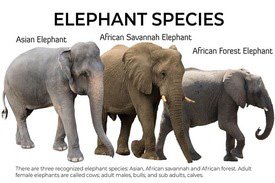
Sri Lankan elephants are a unique subspecies of the Asian elephant. These gentle giants are significant in the island’s biodiversity and cultural fabric. Carl Linnaeus first described the Sri Lankan elephant under the binomial Elephas maximus 1758. In 2014, an estimated 4,000 elephants lived in Sri Lanka. The Sri Lankan elephant is protected under the Fauna and Flora Protection Ordinance of Sri Lanka (FFPO), and killing it carries the death penalty.
Feeding

Elephants in Sri Lanka eat various foods, including grass, leaves, flowers, fruit, and vegetables. They also eat leftover crops and trash. Elephants eat many types of grass, including Cynodon dactylon, Eragrostis tenella, and Panicum repens. Elephants prefer leaves and flowers from grass species like Kitul (Caryota), coconut, jackfruit Cyperaceae exaltatus, Cyperus procerus, and Digitaria bicornis. Also, Elephants like sweet fruit and vegetables such as bananas when available. They consume 150 Kg of food and 100 l of water daily. Elephants typically walk a minimum of 25 kilometers daily to find their food.
Musth Period
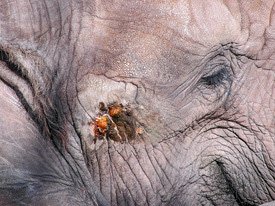
During the musth period, male elephants experience a physiological change that causes them to become more dominant, aggressive, and excitable. This is a natural and healthy part of an elephant’s life and is usually a sign of health. The musth glands secrete a dark, oily, musky substance. Male elephants become more dominant, aggressive, and excitable. They may rub the secretion on trees to mark their territory. Male elephants make a deep vocabulary of sounds to signal strength and virility. Musth can last from a few days to several months. The length of musth depends on the elephant’s health, age, and other factors. Male elephants first experience musth about three years after they reach sexual maturity, which is usually between eight and 15 years of age. In the wild, musth occurs in sexually mature bulls, generally those over 25.
Elephants Gathering

Elephants come to the brink of water, such as tanks, lakes, puddles, marshes, swamps, and riverbanks, to eat grass. They love tender grass because of its high protein content. They gather once a year from July to October when water levels get low, not only for their food but also to find partners for mating. It is difficult for males to find female partners, as they mate once every five years. Mating occurs only for a short period of four to five days. Females sprinkle mating hormones through their urine and defecation for knowing males around. Then, males in their musth try to have that female, and many males fight each other to capture their partner. Sometimes, fighting ends with death. The winner captures the area with a heap of many other elephants. Mostly, a giant tusker becomes the king of the heap. Minneriya Tank Brink’s grass bed in Minneriya National Park is the best example of an elephant gathering in Sri Lanka.
Elephant Corridors
Elephant corridors in Sri Lanka allow elephants to migrate between national parks and other protected areas. These corridors are essential for conserving elephant populations and biodiversity. Minneriya, Dahaiyagala, and Kibissa near Sigiriya are examples of elephant corridors in Sri Lanka.
National Parks
Out of 26 national parks in Sri Lanka, 13 have elephant habitats. Minneriya, Udawalawe, Yala, Wilpattu, Kaudulla, Gal Oya Valley, Wasgamuwa, Lahugala Kitulana, Maduru, Angammedilla, Kumana, Bundala, Lunugamvehera, Flood Plains, Madhu Road, and Somawathiya are the National Parks for Elephants in Sri Lanka. The most popular are Minneriya, Yala, Udawalawe, and Wilpattu.
Elephant sanctuaries
Elephant Orphanage Pinnawala and Elephants Transit HomeUdawalawa are two elephant sanctuaries run by the Department of Wildlife Conservation in Sri Lanka (DWC). The web link of DWC follows immediately.
https://www.mwfc.gov.lk/department-of-wildlife-conservation/
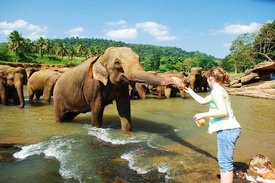
Pinnawala Elephant Orphanage is a captive breeding and conservation institute for wild Asian elephants located at Pinnawala village. Pinnawala has the largest herd of captive elephants in the world. In 2023, there were 71 elephants, including 30 males and 41 females from 3 generations, living in Pinnawala. The orphanage was founded to care and protect the many orphaned unweaned wild elephants found wandering in and near the forests of Sri Lanka. It was established in 1975 by the Sri Lanka Department of Wildlife Conservation (DWC). On 31 August 2021, a 25-year-old elephant named Surangi gave birth to twin male baby elephants at the orphanage. It also marked the first instance of the birth of twin elephants in Sri Lanka after a gap of 80 years since 194.
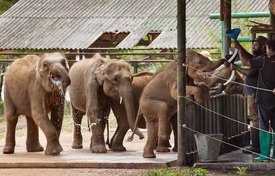
Sri Lankan elephants (Elephas maximus maximus) are an endangered species. The Elephant Transit Home within Udawalawe National Park was established in 1995 by the Department of Wildlife Conservation together with the Born Free Foundation. This complex is a halfway house for orphaned elephants. After rehabilitation, the elephants are released back into the wild, many into the Udawalawe National Park. Although you can’t get up close and personal with the elephants, seeing them at feeding time (from a viewing platform) is still a lot of fun. It’s on the main lakeside road, about 5km west of the Uda Walawe National Park entrance.
Challenges for the Elephants

Human activities, such as building businesses and factories and cultivating crops, can block elephant corridors. Farmers may use acoustic deterrents, such as shouting and firecrackers, to chase away elephants. Habitat loss is another main challenge for Elephants. They need large forest areas, which are being fragmented by human development. Infrastructure development such as roads, reservoirs, and other infrastructure projects disrupt elephant migration patterns and fragment their habitats. The human population is growing rapidly, which leads to more growth and loss of habitat. Human-elephant conflict is caused by habitat loss, and elephants and humans compete for land and resources, which can lead to conflict and death. Crop raiding by elephants, who like to eat crops like bananas and sugar cane, is often grown near human settlements. Electric fences can kill elephants, making it difficult for them to find food and water.
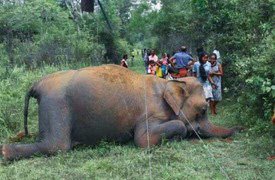
Invasive species are encroaching on elephant reserves. Some people use explosives, called “jaw bombs,” to kill or injure elephants. Trap guns and snares are used for hunting bushmeat and can also injure or kill elephants. Due to tourism, elephants are forced to live closer together, which can lead to aggression. Elephants eat human disposal of garbage near habitats, causing the elephants to suffer from diseases.
The Role of Conservation Efforts
Furthermore, contributing to local conservation initiatives can amplify your impact. Many organizations work tirelessly to protect elephant habitats, mitigate human-animal conflicts, and rehabilitate injured elephants. Donating to or volunteering with these groups provides crucial support to their ongoing efforts, helping to secure a future for Sri Lanka’s dwindling elephant populations. By practicing responsible tourism, you enable a balance between enjoying the beauty of these giants and ensuring their continued survival for generations to come. This approach secures not only the elephants’ well-being but also the cultural and natural heritage of Sri Lanka.
How to Experience Sri Lankan Elephants Responsibly
Experiencing the majestic elephants of Sri Lanka can be a fulfilling endeavor, provided that travelers approach their encounters with sensitivity and responsibility. One of the most effective ways to witness these magnificent creatures is by visiting national parks where they reside in their natural habitats. Yala, Udawalawe, and Minneriya National Park are three prominent options that offer guided safari tours. Such tours allow visitors to observe elephants in the wild without infringing on their territory or disrupting their behaviors. It is essential to choose a licensed tour operator who prioritizes ethical practices and adheres to guidelines set forth by conservation organizations.
We have written a blog post about Safari in Yala National Park for those interested. The link follows immediately.
https://pantheratravels.com/yala-safari/

Another avenue for experiencing elephants is through ethical wildlife tours. These tours often focus on the well-being of the animals and aim to educate participants about their importance in the ecosystem. Look for operators who do not engage in practices exploiting elephants, such as riding them or confining them in small areas. Supporting responsible tours ensures that your visit contributes positively to the animals and the local communities, as a portion of the proceeds often goes towards conservation efforts.

Hope you enjoyed the article. You can scroll down to our featured posts. Before you go to featured posts, Subscribe to read our new posts. We never use this email for promotions and offers. Our only purpose is for you to read our valuable content.
Featured Blog Posts

- Featured, Places

- Featured, Places

- Featured, Travel tips

- Featured, Places

- Activities, Featured

